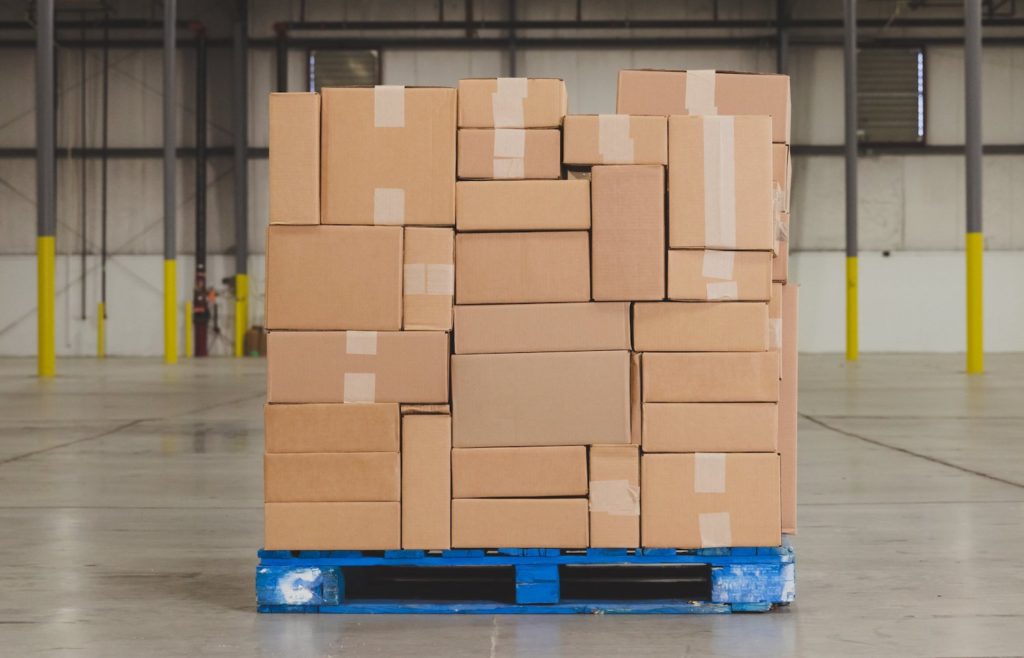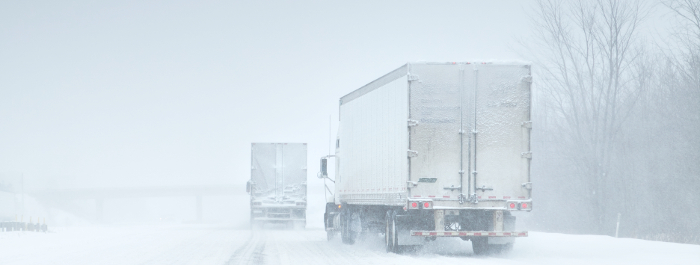
Is Your Supply Chain Prepared For The Next Storm?
By Stephen Bennett & Ryan Barcza
Twenty winters since 1980 have brought one or more significant (or stronger) storms to Northeast U.S. and last month’s blizzard, aka “Jonas,” was crippling. It was the sixth-most impactful storm in Northeast U.S. history (back to 1900) and the most impactful to strike the region since February of 2010. Washington D.C. and New York City both matched or exceeded the largest snowfall amounts observed in more than a hundred years of recordkeeping.
Reports indicate that this storm cost the U.S. economy as much as $1 Billion
That $1B figure represents a significant impact across industries from Jonas, with the food and beverage supply chain one of the hardest hit:
- Over 250,000 individual supply chain nodes experienced “significant” operational impacts
- Over 1.5 million miles of shipping lanes experienced closures or significant delays
- Nearly 10% of sugar input locations for manufacturing had to deal with stoppages
- Over 50% of grocery warehouses were located in the high-impact zone of Jonas and were forced to make tough decisions to halt operations in order keep employees safe
(Source: Riskpulse)
The media typically reports the generalized impact of these storms, and it’s intuitive that that big storms mean big money, but as a single organization, what can you do to avoid these disruptions? How can a large wholesale grocery supply company with more than 75 facilities from coast-to-coast keep bread and milk on its customers’ shelves? How does an extensive dairy producer with over 8,000 supply chain nodes in the US keep its operations in sync during a storm? How can a multi-billion-dollar global food manufacturer with a transportation network exceeding 8 million miles prevent temperature-sensitive product from being stuck on roads and rails?
These are the questions that the Riskpulse team answers each and every day for some of the most complex supply chains in the food and beverage industry.
Swinging into action before the first flakes fall
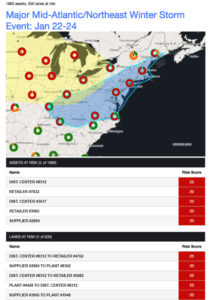 On Monday, January 18th, nearly five full days before record-setting snowfall, our customers saw every supply chain intersecting the Midwest and Northeast U.S. had an “actionable” level of risk. The example to the left is an alert for a single company within a grocery supply chain. Over 1,500 individual supply chain nodes (i.e. store locations, processors, manufacturing plants, warehouses, etc) needed to begin preparing for Jonas.
On Monday, January 18th, nearly five full days before record-setting snowfall, our customers saw every supply chain intersecting the Midwest and Northeast U.S. had an “actionable” level of risk. The example to the left is an alert for a single company within a grocery supply chain. Over 1,500 individual supply chain nodes (i.e. store locations, processors, manufacturing plants, warehouses, etc) needed to begin preparing for Jonas.
The transportation manager identified “over 170,000 miles of road/rail in Jonas’s path are expected to shut-down across our network between Friday and Saturday.” He then started coordinating across his transportation network by speeding up deliveries to distribution centers (DCs), asking suppliers if they should pull safety stock due to delays, and rerouting impacted over-the-road (OTR) shipments.
Another one of our Food & Beverage Shipping Solution customers proactively addressed the threat of Jonas thanks to a daily shipping lane risk report that identified nearly 30 deliveries to a single large customer that would almost certainly suffer storm delays. Due to the advanced notice, the transportation team notified customer service reps of potential delays who then worked with their clients to adjust shipment timing. DCs and stores stayed as well-stocked as possible ahead of the storm.
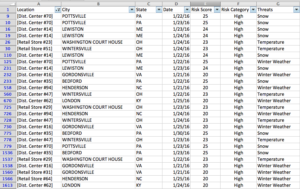
Additionally, a wholesale grocer reported a $1 million spike in sales in a single day just before Jonas hit one of their retail customers. Proactive business continuity and transportation managers avoided disruptions thanks to the coupling of early high confidence forecasts and an understanding of the high impact implications both upstream and downstream. By anticipating a “bread and milk run” before the blizzard, customer service managers and buyers facilitated communications with retailers and shipped excess inventory early to make sure shipments weren’t getting stuck on roads and shelves didn’t go empty when the crush of shoppers hit the store.
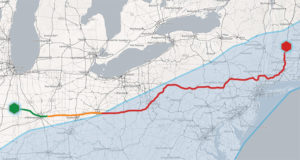
With this level of advanced forecasting, enhanced transportation network visibility, and collaboration tools available for your channel partners, today’s supply chains can become more resilient and adaptive than ever before. It’s now possible to deliver measurable results and avoid the crippling impact of the next winter storm Jonas.
De-mystify weather forecasting
At Riskpulse, we factor “impact” and “uncertainty” into every forecast. We start by tapping the stream of global weather data that includes the full breadth of government-run dynamic weather models in the US, Europe and Canada. Our algorithms crunch massive amounts of data from weather simulations and historical models which are then enhanced by our team of Riskpulse meteorologists who have decades of weather forecasting experience for supply chains around the world. The end result is a highly customized Riskpulse Score (RpS™).
The RpS is the result of predictive weather analytics tailored to our customers’ highly individualized decision / action criteria. RpS-17 or higher (up to a max RpS of 25) triggers our customers to alter their regular workflow to mitigate imminent weather-driven supply chain disruption (or to seize a weather-driven demand opportunity). The figure below shows an example of our “risk timeline” and associated information accessible through the Riskpulse platform.
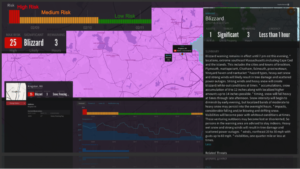
It’s time for the entire food and beverage supply chain to sit up and take notice. It’s no longer acceptable to simply react to these storms as they happen. Customers and partners alike expect proactive behavior ahead of these storms. Not only are significant storm-driven cost savings possible, but with the right information and streamlined communication between supply chain nodes from manufacturer to retailer, revenue-boosting insights can become today’s reality.



